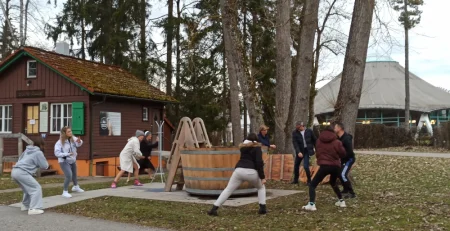For the millions who live with anxiety, the feeling is all too familiar. It’s a rising tide of physiological noise—a racing heart, shallow breathing, and a sense of impending doom that seems to come from nowhere and everywhere at once. It’s your nervous system sounding a false alarm.
While therapy and medication remain the cornerstone of anxiety treatment, emerging research into cold water immersion is uncovering a fascinating, physical way to help calm that alarm — a kind of biological circuit breaker for an anxious mind.
The benefits of the cold plunge for anxiety lie in its ability to hijack the very system that’s causing the problem: your autonomic nervous system.
Table of Contents
A Controlled Hijacking of the Nervous System
Anxiety is often a state of a runaway sympathetic nervous system—the “fight-or-flight” response. It’s as if someone has pressed the gas pedal to the floor and it’s stuck there. Your body is flooded with adrenaline and cortisol, your heart pounds, and your muscles tense, preparing for a threat that isn’t physically present.
When you lower yourself into an ice bathtub, you are voluntarily initiating a massive, but controlled, sympathetic surge. The shock is undeniable. Your heart rate soars, and you gasp for air. But this is a deliberate, conscious act. You are choosing to press the gas pedal yourself, for a defined purpose and a limited time.
And this is where things shift. The body’s innate survival mechanisms kick in. To prevent overdrive and protect the heart, the parasympathetic nervous system—the “rest-and-digest” brake—is powerfully activated to counterbalance the shock. This is largely mediated by the vagus nerve. Cold exposure is one of the most powerful natural stimulators of vagal tone.
So, while the initial shock feels like anxiety, the after-effect is the complete opposite. As you step out and focus on breathing through the shivers, you are feeling your body actively apply the brakes. Your heart rate drops, often to a rate lower than before you entered the water. A deep, physiological calm descends. You have just given your nervous system a masterclass in regulation: you took it to the peak of arousal and guided it back down to safety. Over time, with consistent practice, this can build a stronger, more resilient nervous system that is less prone to launching into false alarms.
The Chemistry of Calm
The biochemical story is equally compelling. Anxiety is often linked with dysregulation in key neurotransmitter systems. The cold plunge directly addresses this:
- Norepinephrine: As discussed with depression, the cold triggers a significant release of norepinephrine. This chemical isn’t just about alertness; it plays a crucial role in focus and attention. For an anxious mind spinning with a cyclone of “what-ifs,” this surge can create a moment of sharp, single-pointed focus. The noise is replaced by a single directive: “Breathe. Endure.” This can be a powerful form of cognitive reset, pulling you out of the abstract future and anchoring you into now.
- Endocannabinoids: This is a key player in the “after-glow.” The stressful stimulus of the cold prompts the release of the body’s own endocannabinoids, like anandamide (often called the “bliss molecule”). These neurotransmitters bind to the same receptors as compounds in cannabis, promoting feelings of peace, well-being, and reduced sensitivity to pain and stress. This is biochemical proof that your body can generate its own anti-anxiety chemistry.
These 2 shifts create what many describe as reset energy — a mix of focus, calm, and emotional lightness that lasts long after you’ve towelled off.
A Practice in Agency and Exposure
Beyond the biology, cold plunging has a profound psychological benefit. Anxiety thrives on helplessness — the feeling that your body and mind are acting against you. The act of willingly facing the intense discomfort of a cold plunge and coming out the other side is a powerful assertion of control. It is a tangible, physical victory that says, “I can handle difficult things.” This builds what psychologists call distress tolerance.
Cold plunging also works as a form of exposure therapy. You are repeatedly exposing yourself to a stressful stimulus (the cold) in a safe environment and learning that you can tolerate the sensations without anything truly bad happening. You learn that the panic peaks and then it passes. This practice can then be generalized to the psychological sensations of anxiety, teaching the mind the same lesson: “This feeling is intense, but it is temporary, and I can ride it out.”
In essence, a cold plunge doesn’t just make you feel calm — it trains your physiology in how to become calm. With regular practice, it builds a bridge between body and mind, helping you move more easily from panic to peace.
Bottom Line
Cold plunging isn’t a replacement for therapy or medication, but it’s a powerful complement, a tool that helps reset the body’s stress response from the inside out. Each plunge is a mini lesson in resilience: you face the rush, you breathe through it, and you emerge quieter, stronger, and just a little more in control. Read more in our guide on how a cold plunge rewires your stress response.
For Further Study
- Systematic Review: “The use of ice baths in recovery from exercise: a systematic review” (Bleakley et al., 2021, British Journal of Sports Medicine). This review consolidates evidence on how cold water immersion influences inflammation, recovery, and nervous system regulation—mechanisms that overlap with anxiety and stress resilience.
- The Huberman Lab Podcast: Neuroscientist Dr. Andrew Huberman provides a deep, accessible dive into “The Science and Use of Cold Exposure for Health and Performance,” with specific explanations of its effects on dopamine and norepinephrine and their link to mood and focus.
- Medical Hypothesis Paper: This article, “Cold Stress and Its Impact on the Nervous System,” explores the broader concept of how controlled cold exposure can lead to adaptations that improve stress resilience.












Leave a Reply